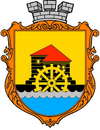Mlyniv
|
Mlyniv Млинів |
|||
|---|---|---|---|
| Urban-type settlement | |||
|
|||
| Location of Mlyniv in Ukraine | |||
| Coordinates: 50°30′50″N 25°36′24″E / 50.51389°N 25.60667°ECoordinates: 50°30′50″N 25°36′24″E / 50.51389°N 25.60667°E | |||
| Country |
|
||
| Province |
|
||
| District | Mlyniv Raion | ||
| Founded | 1445 | ||
| Town status | 1959 | ||
| Government | |||
| • Town Head | Serhiy Vorobei | ||
| Area | |||
| • Total | 20.52 km2 (7.92 sq mi) | ||
| Elevation | 191 m (627 ft) | ||
| Population (2001) | |||
| • Total | 8,446 | ||
| • Density | 410/km2 (1,100/sq mi) | ||
| Time zone | EET (UTC+2) | ||
| • Summer (DST) | EEST (UTC+3) | ||
| Postal code | 35100 | ||
| Area code | +380 3659 | ||
| Website | http://rada.gov.ua/ | ||
Mlyniv (Ukrainian: Млинів; Polish: Młynów) is an urban-type settlement in Rivne Oblast (province) in western Ukraine. Mlyniv is also the administrative center of the Mlyniv Raion (district), housing the district's local administration buildings. Its population is 8,446 as of the 2001 Ukrainian Census. The town is located on the banks of the Ikva River, a tributary of the Styr. Before the Nazi German and Soviet invasions of Poland the village was located in the Wołyń Voivodeship of the Second Polish Republic.
A settlement named Muravytsi or Moravytsi (Ukrainian: Муравиці, Моравиці) first appeared in the town's current borders around 1149. Mlyniv itself was first founded as a village in 1508; it was granted Magdeburg rights by the Polish king in 1789, before the Second Partition of Poland. It acquired the status of an urban-type settlement in 1959 in Soviet Ukraine.
Before the Soviet invasion of Poland in 1939 during World War II, Młynów was a Polish and Jewish town and a Catholic parish in powiat Dubno. The invading Red Army stationed in the area for two years. A number of prominent Polish families were sent to Siberia by the NKVD in 1940. Młynów was overrun by the German army in Operation Barbarossa of 1941. Between 1942 and 1945 it was one of many sites of massacres of Poles and Jews committed by the death squads of Ukrainian Insurgent Army and the local Ukrainian peasants. Notably, the Ukrainian sotnia led by Hryrory Levko ("Kruk") operated in the area until 1947, long after the Soviet counter-offensive of 1944. The Polish self-defence in Młynów managed to hold back the repeated raids by the Ukrainian nationalists as one of only several such outpost, which also included the civilian defence of Kurdybań Warkowicki, Lubomirka, Klewań, Rokitno, Budki Snowidowickie, and Osty. Their survival could be at least partly explained by the Nazi German presence there before the Soviet takeover. During the Polish population transfers (1944–46) the remaining Polish inhabitants of Młynów (now,Mlyniv) have been expelled.
...
Wikipedia



